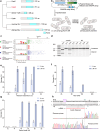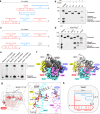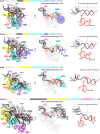Structural basis for target DNA cleavage and guide RNA processing by CRISPR-Casλ2
- PMID: 40473912
- PMCID: PMC12141684
- DOI: 10.1038/s42003-025-08300-8
Structural basis for target DNA cleavage and guide RNA processing by CRISPR-Casλ2
Abstract
RNA-guided CRISPR-Cas nucleases are widely used as versatile genome-engineering tools. Among the diverse CRISPR-Cas effectors, CRISPR-Casλ-also referred to as Cas12n-is a recently identified miniature type V nuclease encoded in phage genomes. Given its demonstrated nuclease activity in both mammalian and plant cells, Casλ has emerged as a promising candidate for genome-editing applications. However, the precise molecular mechanisms of Casλ family enzymes remain poorly understood. In this study, we report the identification and detailed biochemical and structural characterizations of CRISPR-Casλ2. The cryo-electron microscopy structures of Casλ2 in five different functional states unveiled the dynamic domain rearrangements during its activation. Our biochemical analyses indicated that Casλ2 processes its precursor crRNA to a mature crRNA using the RuvC active site through a unique ruler mechanism, in which Casλ2 defines the spacer length of the mature crRNA. Furthermore, structural comparisons of Casλ2 with Casλ1 and CasΦ highlighted the diversity and conservation of phage-encoded type V CRISPR-Cas enzymes. Collectively, our findings augment the mechanistic understanding of diverse CRISPR-Cas nucleases and establish a framework for rational engineering of the CRISPR-Casλ-based genome-editing platform.
© 2025. The Author(s).
Conflict of interest statement
Competing interests: G.M., A.J.G., A.O., L.E.A., G.R.H., T.D., W.X.Y., D.R.C., D.A.S., and Z.M. are current or former employees and shareholders of Arbor Biotechnologies. Arbor Biotechnologies has filed patents related to this work. The remaining authors declare no competing interests.
Figures







References
-
- Hille, F. et al. The Biology of CRISPR-Cas: Backward and Forward. Cell172, 1239–1259 (2018). - PubMed
MeSH terms
Substances
Grants and funding
LinkOut - more resources
Full Text Sources

